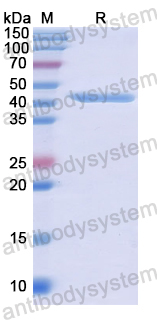Catalog No.
YHJ34201
Expression system
E. coli
Species
Homo sapiens (Human)
Protein length
Thr437-Val792
Predicted molecular weight
43.78 kDa
Nature
Recombinant
Endotoxin level
Please contact with the lab for this information.
Purity
>90% as determined by SDS-PAGE.
Accession
Q92878
Applications
ELISA, Immunogen, SDS-PAGE, WB, Bioactivity testing in progress
Form
Lyophilized
Storage buffer
Lyophilized from a solution in PBS pH 7.4, 0.02% NLS, 1mM EDTA, 4% Trehalose, 1% Mannitol.
Reconstitution
Reconstitute in sterile water for a stock solution. A copy of datasheet will be provided with the products, please refer to it for details.
Shipping
In general, proteins are provided as lyophilized powder/frozen liquid. They are shipped out with dry ice/blue ice unless customers require otherwise.
Stability and Storage
Use a manual defrost freezer and avoid repeated freeze thaw cycles. Store at 2 to 8°C for frequent use. Store at -20 to -80°C for twelve months from the date of receipt.
Alternative Names
RAD50, hRAD50, DNA repair protein RAD50
Genome rearrangements induced by the stimulation of end-joining of DNA double strand breaks through multiple phosphorylation of MRE11 by the kinase PKB/AKT1., PMID:40479710
PRDX1 protects ATM from arsenite-induced proteotoxicity and maintains its stability during DNA damage signaling., PMID:40387816
Inherited deficiency of DIAPH1 identifies a DNA double strand break repair pathway regulated by γ-actin., PMID:40368919
WDR11-DT enhances radiosensitivity via promoting PARP1 degradation and homologous recombination deficiency., PMID:40320037
Genetic Features of Tumours Arising in the Context of Suspected Hereditary Cancer Syndromes with RAD50, RAD51C/D, and BRIP1 Germline Mutations, Results of NGS-Reanalysis of BRCA/MMR-Negative Families., PMID:40282418
NBS1 from Physcomitrium patens confers resistance against oxidative stress through the BRCA1 C-terminus (BRCT) domain, independent of the MRE11 interaction., PMID:40250013
ATM priming and end resection-coupled phosphorylation of MRE11 is important for fork protection and replication restart., PMID:40249789
Mouse MRE11-RAD50-NBS1 is needed to start and extend meiotic DNA end resection., PMID:40240347
Germline variants in patients from the Iranian hereditary colorectal cancer registry., PMID:40223084
Comprehensive structural and functional analyses of RAD50 nsSNPs: from prediction to impact assessment., PMID:40206634
Role of MRE11 in DNA damage repair pathway dynamics and its diagnostic and prognostic significance in hereditary breast and ovarian cancer., PMID:40205351
Dynamic conformations of the P. furiosus MR-DNA complex link Mre11 nuclease activity to DNA-stimulated Rad50 ATP hydrolysis., PMID:40175510
Connexin46 in the nucleus of cancer cells: a possible role as transcription modulator., PMID:40148950
NBS1 facilitates preribosomal RNA biogenesis., PMID:40067889
PLK1 phosphorylates WRN at replication forks., PMID:40023583
Population-based study of recurrent DNA damage response gene variants in breast cancer cases., PMID:40009290
Phosphorylated BLM peptide acts as an agonist for DNA damage response., PMID:39997217
Oxidative damage to DNA, expression of Mt-1, and activation of repair mechanisms induced by vanadium trioxide in cultures of human lymphocytes., PMID:39897397
Transcription near arrested DNA replication forks triggers ribosomal DNA copy number changes., PMID:39876709
Hepatitis B virus hijacks MRE11-RAD50-NBS1 complex to form its minichromosome., PMID:39752632
DNA repair protein RAD50 is involved in the streptozotocin-induced diabetes susceptibility of mice., PMID:39721698
Structure guided functional analysis of the S. cerevisiae Mre11 complex., PMID:39711558
Genome-wide identification and characterization of circular RNAs for exogenous trehalose-mediated heat stress responses in tea plants (Camellia sinensis)., PMID:39703553
Interaction of DDB1 with NBS1 in a DNA Damage Checkpoint Pathway., PMID:39684807
A deep intronic mutation causes RAD50 deficiency through an unusual mechanism of distant exon activation., PMID:39666384
Saccharomyces cerevisiae Rev7 promotes non-homologous end-joining by blocking Mre11 nuclease and Rad50's ATPase activities and homologous recombination., PMID:39630591
Phase II Trial of the PARP Inhibitor, Niraparib, in BAP1 and Other DNA Damage Response Pathway-Deficient Neoplasms., PMID:39626160
Meiotic DNA break resection and recombination rely on chromatin remodeler Fun30., PMID:39613969
STK39-mediated amplification of γ-H2A.X promotes homologous recombination and contributes to PARP inhibitor resistance., PMID:39588777
Multi-target therapeutic modulation with natural compounds towards DNA repair MRN-checkpoint sensor genes (MRN-CSGs) and oncogenic miRNAs in breast cancer patients: a Clinico-Informatic study., PMID:39568384
Functional and molecular insights into the role of Sae2 C-terminus in the activation of MRX endonuclease., PMID:39558159
Germline Variants in DNA Interstrand-Cross Link Repair Genes May Contribute to Increased Susceptibility for Serrated Polyposis Syndrome., PMID:39519399
EZH1/2 plays critical roles in oocyte meiosis prophase I in mice., PMID:39511641
Cohesin complex oligomerization maintains end-tethering at DNA double-strand breaks., PMID:39482358
Chronic interferon-stimulated gene transcription promotes oncogene-induced breast cancer., PMID:39455282
S6K1 Controls DNA Damage Signaling Modulated by the MRN Complex to Induce Radioresistance in Lung Cancer., PMID:39408794
Mechanism of BRCA1-BARD1 function in DNA end resection and DNA protection., PMID:39261728
Targeting DNA damage repair mechanism by using RAD50-silencing siRNA nanoparticles to enhance radiotherapy in triple negative breast cancer., PMID:39221201
Deficiency in Epithelium RAD50 Aggravates UC via IL-6-Mediated JAK1/2-STAT3 Signaling and Promotes Development of Colitis-Associated Cancer in Mice., PMID:39207300
From the TOP: Formation, recognition and resolution of topoisomerase DNA protein crosslinks., PMID:39180935
RAD51 protects abasic sites to prevent replication fork breakage., PMID:39178838
Lamin A/C facilitates DNA damage response by modulating ATM signaling and homologous recombination pathways., PMID:39176289
Sae2 controls Mre11 endo- and exonuclease activities by different mechanisms., PMID:39174552
Targeted DNA Sequencing in Diagnosis of Malignant Phyllodes Tumors With Emphasis on Tumors With Keratin and p63 Expression., PMID:39154782
SingleNucleotide Polymorphisms as Biomarkers of Mepolizumab and Benralizumab Treatment Response in Severe Eosinophilic Asthma., PMID:39125709
Alterations in the expression of homologous recombination repair (HRR) genes in breast cancer tissues considering germline BRCA1/2 mutation status., PMID:39080120
Intermolecular Gene Conversion for the Equalization of Genome Copies in the Polyploid Haloarchaeon Haloferax volcanii: Identification of Important Proteins., PMID:39062640
Predictive modeling of gene mutations for the survival outcomes of epithelial ovarian cancer patients., PMID:38976671
NBS1 lactylation is required for efficient DNA repair and chemotherapy resistance., PMID:38961290
Expression patterns of mismatch repair proteins in cervical cancer uncover independent prognostic value of MSH-2., PMID:38950928

